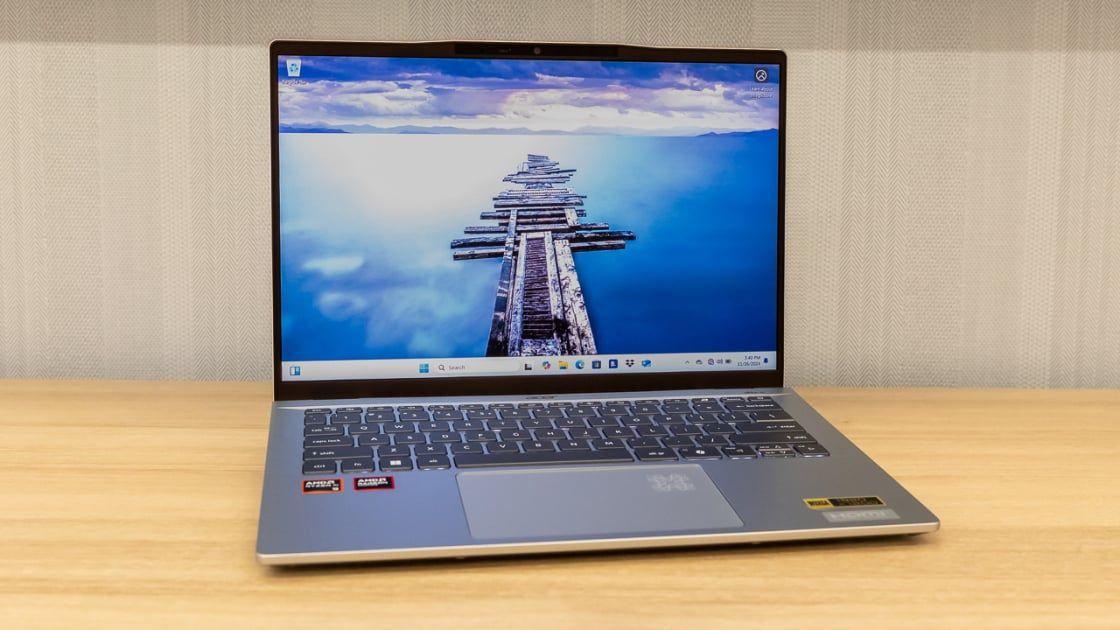Acer Swift 14 AI AMD: A Capable Ultraportable with AI Features, but Faces Stiff Competition
2 Sources
2 Sources
[1]
Acer Swift 14 AI AMD Review
What's one way to charge more than $1,000 for a laptop in this day and age? Slap an "AI" sticker on it. Acer is not the only offender -- looking at you, Microsoft, forcing your Copilot key onto keyboards -- but the company has enthusiastically boarded the bandwagon with the Swift 14 AI AMD (starts at $1,199.99; $1,299.99 as tested), a notebook with a squiggly symbol on the touchpad that lights up when you use an AI app. Artificial hoopla aside, the Swift is a capable ultraportable laptop. However, it fails to unseat the Editors' Choice-award-winning Asus Zenbook 14 OLED Touch (UM3406), which isn't as fast but has a superior screen and costs hundreds less. Configurations and Design: Covering All the CPU Bases The Swift 14 AI AMD -- you'll find Intel and Arm versions, too -- starts at $1,199.99 with 16GB of RAM, which is on sale for $999 at the time of publishing. However, this test unit (model SF14-61T-R3U1) doubles the memory for an extra $100. It also carries a 10-core AMD Ryzen AI 9 365 processor with Radeon 880M integrated graphics, a 1TB NVMe solid-state drive, and a 14-inch, 1,920-by-1,200-pixel IPS touch screen. The system's web page on Acer.com trumpets two non-touch display options with higher 3K resolution -- one IPS with a 120Hz refresh rate and one OLED with 90Hz -- but Acer disappointingly confirms they're not available in the U.S. On the positive side, the Swift lands right on our ultraportable weight line at 3.0 pounds, compared with 3.47 pounds for the HP OmniBook Ultra 14. Measuring 0.74 by 12.3 by 8.8 inches, it's a fraction trimmer than that laptop as well. Its anodized aluminum chassis has passed MIL-STD 810H tests for sturdiness, but you'll still feel a bit of flex if you grasp the screen corners or press the keyboard deck. Slim bezels surround the screen, which opens 180 degrees and has a top lip to ease one-handed opening. The 1440p webcam centered above has a sliding privacy shutter and IR face recognition, joining a fingerprint reader embedded in the power button to give you two ways to skip passwords with Windows Hello. The laptop's left side holds two USB4 Type-C ports, either suitable for the AC adapter, along with an always-on USB 3.2 Type-A port and an HDMI monitor port. Another USB-A port joins an audio jack at the right. Along with Wi-Fi 7 and Bluetooth, this is a satisfactory array of connections. However, I would be happier with USB-C ports on both sides (so the AC adapter cord can't interfere with external mouse users) and an option for mobile broadband. Using the Acer Swift 14 AI AMD: Ai-Yi-Yi, It's AI Along with the usual shortcuts for screen brightness, audio volume, and airplane mode, the top row has a key to launch AcerSense, a utility that combines system info and updates, diagnostics, power/cooling settings, and three Windows Store apps. These are LiveArt, which creates AI-filtered stickers from your photos; AlterView, which provides adjustable animated wallpapers; and GIMP, the robust but less consumer-friendly rival to Adobe Photoshop. A feature called Acer User Sensing taps the IR webcam to log you in when you approach and dim the screen or lock the system when you move away, as well as nagging you to take regular screen breaks and not get too close to the display. Acer QuickPanel pops up during video calls to provide AI-enhanced PurifiedView image and PurifiedVoice audio enhancements. And as always with Acer PCs, you'll see a few bloatware ads for things like the Forge of Empires game. PurifiedView mostly duplicates Windows Camera's recently added auto framing, background blur, and video fine-tuning for the webcam. The camera captures images that are brighter and sharper than average, with quadruple the resolution of cheapo 720p cams. Sound from the bottom-mounted speakers is moderately loud but somewhat scratchy and hollow; you'll hear little bass, but you can make out overlapping tracks. DTS:X Ultra software offers music, movie, gaming, and other audio presets (my ears couldn't detect much difference) plus an equalizer. The keyboard commits two common laptop sins: teaming the cursor arrow and Fn keys instead of providing dedicated Home, End, Page Up, and Page Down keys and arranging those arrows in a clumsy row (with half-size up and down stacked between full-size left and right) instead of an inverted T. Its typing feel is decidedly shallow and flat, uncomfortable for long sessions. The sizable, buttonless touchpad glides and taps smoothly and takes medium pressure for a comfortable click. I could wish for higher resolution, but the 16:10-aspect-ratio touch screen is sufficiently bright, with clean instead of dingy white backgrounds and broad viewing angles. Its colors don't pop like poster paints but are rich and well-saturated, with decent contrast. The screen's finer details are crisp, and you'll see no pixelation around the edges of letters. Testing the Acer Swift 14 AI AMD: Near the Head of the Class You'll find no shortage of other 14-inch ultraportables to compare the Swift AI 14 with -- or wanna-be ultraportables, I should say -- since several edge over our three-pound limit. The Dell XPS 14 and Asus Zenbook S 14 have Intel Core Ultra 7 power. So does our test unit's more costly cousin, the Acer Swift X 14, whose Nvidia GeForce RTX 4070 instead of integrated graphics makes it the champion of our GPU benchmarks. The HP OmniBook Ultra 14 has an AMD Ryzen AI 9 processor like our Acer's. Productivity and Content Creation Tests Our primary overall benchmark, UL's PCMark 10, tests a system in productivity apps ranging from web browsing to word processing and spreadsheet work. Its Full System Drive subtest measures a PC's storage throughput. Three more tests are CPU-centric or processor-intensive. Maxon's Cinebench 2024 uses that company's Cinema 4D engine to render a complex scene; Primate Labs' Geekbench 6.3 Pro simulates popular apps ranging from PDF rendering and speech recognition to machine learning; and we see how long it takes the video editing tool HandBrake 1.8 to convert a 12-minute clip from 4K to 1080p resolution. Finally, workstation maker Puget Systems' PugetBench for Creators rates a PC's image editing prowess with a variety of automated operations in Adobe Photoshop 25. Compared with larger desktop replacement notebooks, the ultraportable performance baseline is usually decent workflow with everyday apps like Microsoft 365 or Google Workspace -- say, 4,000 to 5,000 points in PCMark 10's main event. The Swift 14 AI AMD raises the bar, joining HP's OmniBook (which has a slightly higher-rated Ryzen AI chip) in crushing our processing tests. It's certainly suitable for content creation as well as routine productivity. Graphics Tests We challenge laptops' graphics with a quartet of animations or gaming simulations from UL's 3DMark test suite. Wild Life (1440p) and Wild Life Extreme (4K) use the Vulkan graphics API to measure GPU speeds. Steel Nomad's regular and Light subtests focus on APIs more commonly used for game development, like Metal and DirectX 12, to assess gaming geometry and particle effects. A fifth test, Solar Bay, emphasizes ray-tracing performance. AMD's integrated graphics were not quite a match for Intel's, which in turn were no match for the Dell's entry-level discrete GPU, let alone the two-steps-higher RTX 4070 inside the Swift X. Most ultraportables are fine for solitaire games and video streaming, not playing the latest fast-twitch titles. Battery and Display Tests We test each laptop's battery life by playing a locally stored 720p video file (the open-source Blender movie Tears of Steel) with display brightness at 50% and audio volume at 100%. We make sure the battery is fully charged before the test, with Wi-Fi and keyboard backlighting turned off. To gauge display performance, we also use a Datacolor SpyderX Elite monitor calibration sensor and Windows software to measure a laptop screen's color saturation -- what percentage of the sRGB, Adobe RGB, and DCI-P3 color gamuts or palettes the display can show -- and its 50% and peak brightness in nits (candelas per square meter). The Acer AI AMD did about as well as an IPS- rather than OLED-screened slimline can in these tests, combining lengthy battery life and screen brightness with decent color reproduction. However, I still wish Acer would sell the 3K OLED display as an option here in the States. Verdict: Embrace the Hype? We have a perhaps stereotypical view of most Acer customers as non-tech-expert consumers rather than power users, so we're not surprised the Swift 14 AI AMD does everything but put a cereal- or detergent-style "Now with AI!" decal on the box. Those looking inside the box, however, will find exceptional processing power and webcam quality. The stiff, flat keyboard dampens the experience, and other 14-inch ultraportables, like the Asus Zenbook 14 OLED Touch, include prettier OLED screens, but this Acer should satisfy many.
[2]
Sometimes a "no compromise" laptop comes with too many compromises
The Acer Swift 16 AI needed one killer feature to make it stand out When I look at the buying guides I've curated for Laptop Mag, nearly every best laptop has at least one glaring drawback floating in a sea of stellar features. Even if those laptops are more expensive, one or more of those features can be worth the extra cost if they are too awesome to ignore. So, when I feel underwhelmed by a laptop, it's usually because it's trying to appeal to a general audience. That's how I feel about the Acer Swift 16 AI (Intel). It performs well but is not the best for heavy multitaskers. It has a long battery life, but it's not the longest. It's thin and light for a 16-inch laptop but still a little awkward to handle. It's competitively priced, but so are other laptops in its class -- that have better performance, battery life, or a better design. True balance is hard to achieve on a laptop; one feature needs to be compromised to make another stand out enough to make it appealing. But compromising a little of every feature for the sake of balance makes for a lackluster laptop -- and the Acer Swift 16 AI has compromises in nearly all its features. OLED displays are generally an automatic feature in high-end laptops today, especially ones with high resolutions. They produce stunning colors and sharp and detailed images, so who wouldn't want one on a laptop? But they are power-hungry. I'll dive into the Acer Swift shortly, but first, I want to set the stage with the Dell XPS 14 OLED we reviewed in April 2024. Its battery lasted 9 hours and 35 minutes in our tests, while the IPS model lasted a little over 10 hours. 25 minutes of battery life isn't that much of a loss, but Laptop Mag performs its battery rundown test the same way on every laptop (with the display set to 150 nits of brightness); it's clear OLED uses more energy to emit the same amount of light as IPS. They also don't get as bright, a common criticism of OLED, as many laptop companies offer both IPS and OLED options. Don't love the XPS 14's 377 nits of brightness? The IPS version can handle 461 nits. Some companies like Dell have started to address the issue by using tandem OLED displays in their devices, but double OLED panels mean more battery drain; Dell's non-OLED XPS 13 lasted 18 hours and 34 minutes in our tests, while the OLED model managed just 8 hours and 40 minutes, a massive decline for just 20 extra nits over the IPS model. Power efficiency is even more important for a 16-inch laptop like Acer's Swift 16 AI since a larger screen uses more battery power. It lasted just under 13 hours in our battery test (the average for premium laptops), so there wasn't wiggle room to make its 384-nit display brighter without making its battery life less competitive. An IPS display would have made sense as another option, but perhaps Acer didn't want to saddle its high-end (and only 16-inch) Swift laptop with a display commonly associated with cheaper laptops. The biggest factor impacting battery life is its size, which in turn is affected by the design of the laptop. Example: the 16-inch Swift has a 69 Watt hour (Wh) battery, but the 14-inch Swift I reviewed has a 65 Wh battery. Other things beyond a laptop's design are considered when companies decide how large of a battery it needs, of course -- but the design is a major factor, especially if a company wants to make the thinnest and lightest laptop possible. The Acer Swift 16 AI is 0.39 inches at its thinnest point and 0.69 inches at its thickest, but companies like MSI and Asus figured out how to make slimmer 16-inch laptops with much larger batteries inside. MSI's Prestige 16 AI Evo has a 99.9 Wh battery and gets just over 13 hours of battery life (its 4K display resolution is higher than the Swift's 3K). Asus' Zenbook S 16 has a 78 Wh battery in a chassis that's 0.47-0.51 inches thick and a 3K OLED display with a max brightness of 458 nits. It gets under 11 hours of battery life, but trading two hours of battery life for an incredibly bright OLED display in a wildly slim chassis is worth it. Naturally, cost was another factor driving Acer's decisions on the specs. It might have pushed the laptop out of even more people's budgets. However, considering that other companies have proven it's possible to stick a high-capacity battery inside thinner laptops, this could have been the easiest way for Acer to stand out, even if it didn't change the Swift's dimensions. Acer doesn't have a say in how chipmakers design their processors, but it can choose which ones it wants to put in its laptops. Potential buyers have their pick of either an AMD, Intel, or Qualcomm chip in any of the 14-inch Swift AI laptops, which is nice -- but the 16-inch is only configured with an Intel Core Ultra 200-series chip. I am not a fan of Intel's Lunar Lake chips. Their multicore performance is slower than what I need as a heavy multitasker (and slower than its direct competitors), so if the Swift 16 AI came with an AMD Ryzen AI chip or Qualcomm Snapdragon X Elite chip, I would have been much more excited about this laptop for the giant leap in multitasking performance alone. A Qualcomm chip most likely would have brought the best battery life with it, too. The Swift 14 AI Snapdragon's battery lasted 2 more hours compared to the Intel model, though some of that could be attributed to its larger battery (75Wh versus the Intel's 65 Wh). But the size of the battery and the laptop's power efficiency won't matter to most people -- just how long the laptop can hold a charge and how well it performs. For those willing to stretch their budgets for the right set of laptop features, the Swift 16 AI isn't that persuasive of a machine. It's stripped down to the basics with a little extra flare, but it's no MSI Prestige or Asus Zenbook, or even an HP Spectre x360 2-in-1. All the compromises in those laptops don't look like much of a sacrifice since they have a laundry list of compelling features. They are more expensive, yes, and the Swift could appeal to some budget-conscious buyers for its no-muss, no-fuss attitude. But I believe most people should try to wait for a sale on the laptop they want instead of going with an option that won't make them as happy. It's the reason I put off buying a new laptop for years. I wanted to find the "right one," not just to have one "right now."
Share
Share
Copy Link
Acer's Swift 14 AI AMD laptop offers AI capabilities and solid performance, but struggles to justify its price point against competitors with better features.

Acer Swift 14 AI AMD: An AI-Enhanced Ultraportable
Acer has joined the AI laptop trend with its Swift 14 AI AMD, a capable ultraportable that starts at $1,199
1
. The laptop features a squiggly symbol on the touchpad that illuminates when using AI applications, attempting to justify its premium price point.Key Specifications and Design
The tested model (SF14-61T-R3U1) boasts a 10-core AMD Ryzen AI 9 365 processor, 32GB of RAM, a 1TB NVMe SSD, and a 14-inch 1,920-by-1,200-pixel IPS touch screen
1
. Weighing 3 pounds and measuring 0.59 by 12.2 by 8.4 inches, the Swift 14 AI AMD meets ultraportable standards.AI Features and Software
Acer has incorporated several AI-enhanced features:
- AcerSense utility for system management and AI apps
- User Sensing for automatic login and screen management
- QuickPanel for AI-enhanced image and audio during video calls
- PurifiedView and PurifiedVoice for webcam and audio improvements
Performance and Usability
While the Swift 14 AI AMD offers solid performance, it falls short of outperforming competitors in its price range. The keyboard layout has some ergonomic issues, and the typing experience is described as shallow and flat
1
.Display and Audio
The 16:10 aspect ratio touch screen provides adequate brightness and color reproduction. The bottom-mounted speakers deliver moderate volume but lack bass
1
.Battery Life and Connectivity
The laptop includes two USB4 Type-C ports, two USB 3.2 Type-A ports, an HDMI port, and Wi-Fi 7 connectivity. Battery life is competitive but not exceptional for its class
1
.Comparison with Competitors
The Acer Swift 16 AI, a larger variant, faces stiff competition from other 16-inch laptops. Competitors like MSI's Prestige 16 AI Evo and Asus' Zenbook S 16 offer larger batteries, slimmer designs, or brighter displays
2
.Market Positioning and Challenges
Acer's attempt to create a balanced, general-purpose laptop may have resulted in compromises across multiple features. The lack of standout characteristics makes it difficult for the Swift series to differentiate itself in a crowded market
2
.Processor Options and Performance Considerations
While the 14-inch Swift AI offers AMD, Intel, and Qualcomm chip options, the 16-inch model is limited to Intel Core Ultra 200-series processors. This restriction may disappoint users seeking alternatives with potentially better multi-core performance or battery efficiency
2
.In conclusion, while the Acer Swift 14 AI AMD and its larger counterpart offer capable performance and AI features, they struggle to stand out in a competitive landscape. The balance between features, performance, and price may not be compelling enough for budget-conscious consumers or those seeking exceptional capabilities in specific areas.
References
Summarized by
Navi
[1]






